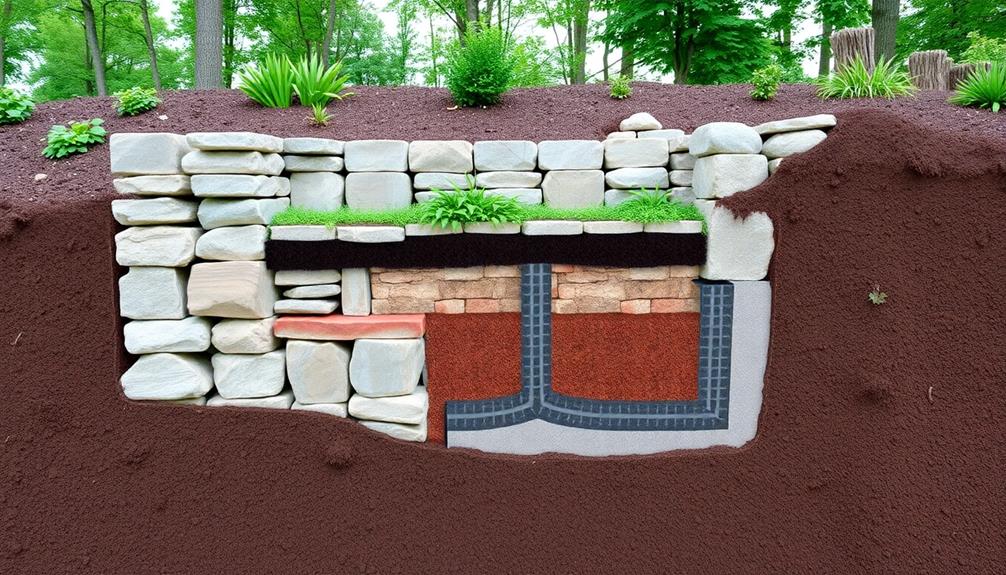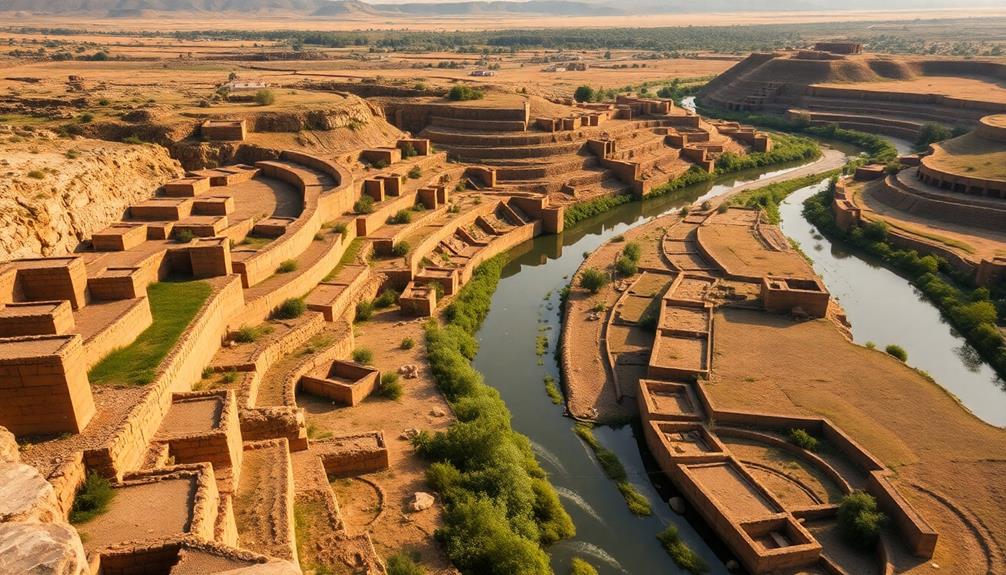The history of retaining wall construction is rooted in ancient Mesopotamia, where early innovations laid the groundwork for modern techniques. Utilizing materials such as stone and mud-brick, these structures addressed critical urban planning needs by preventing soil erosion and stabilizing landscapes. Retaining walls evolved from basic gravity-based designs using heft to modern reinforcements with concrete and steel, illustrating an enduring mastery over structural integrity and resource management. The integration of geosynthetics further advanced capabilities, enabling sustainable, cost-effective solutions. As engineering concepts matured, so did the ability to creatively integrate retaining walls into urban and natural landscapes, setting the stage for further exploration.
Table of Contents
ToggleWalls Contractor Highlights
- Retaining walls date back to ancient Mesopotamia, utilizing stone and mud-brick for soil stabilization.
- Early constructions incorporated basic engineering techniques suited to available resources and climate conditions.
- Traditional masonry walls emphasized aesthetics and durability, using natural stone with mortared or dry-stacked techniques.
- The introduction of concrete and steel enhanced structural integrity and adaptability to diverse conditions.
- Modern advancements include geosynthetic materials, promoting sustainability and improved soil-structure interaction.
Definition of Retaining Walls

Retaining walls are critical structural elements designed to resist lateral pressures from soil or water, playing a pivotal role in landscape stability and preventing erosion. They are often used to create usable spaces for gardening, patios, and parking.
Additionally, boulder retaining walls are known for their long-term and cost-effective benefits. The construction of these walls involves a variety of materials, such as concrete, stone, or timber, each selected based on the specific needs of the site and the desired aesthetic outcome.
Engineering and design considerations are paramount, ensuring that the walls not only fulfill their functional purposes but also comply with safety standards and integrate seamlessly into their surroundings.
Purpose and Functionality
Why do retaining walls occupy such a fundamental role in landscape and construction? These structures are integral in managing earth movement and addressing elevation changes, essentially forming the backbone of various civil and residential projects. Retaining walls serve primarily to stabilize terrain by redistributing lateral earth pressure that would otherwise lead to erosion or structural collapse. They create usable land on slopes, paving the way for the construction of homes, gardens, and roads, thereby enhancing both safety and aesthetic appeal.
The functionality of retaining walls extends beyond mere soil retention; they are designed to accommodate site-specific conditions, such as water drainage and differing soil compositions. Incorporating elements like weep holes and drainage systems, these walls maintain structural integrity by preventing water accumulation, which could increase hydrostatic pressure and lead to failure. This adaptability underscores their enduring significance throughout history.
Engaging with communities requires an understanding of how these walls integrate functionality with design, reinforcing a sense of place and identity. As guardians of the landscape, retaining walls blend engineering precision with communal aesthetics, preserving both the environment's natural beauty and the safety of built environments. Through careful planning and construction, they manifest the harmonious coexistence of nature and human ingenuity.
Materials and Methods
Integral to the functionality discussed earlier, the materials and methods employed in constructing retaining walls are fundamentally varied to suit diverse applications and geological conditions. Historically, the selection of materials depended considerably on availability, cost, and the environmental constraints of the project site. Traditional materials, such as stone and timber, have been employed for centuries due to their natural availability and aesthetic appeal.
Stone masonry remains a popular choice for its strength, durability, and timeless look, while timber offers a more economical option with easy workability and natural aesthetic, though it may require regular maintenance to prevent decay.
In more contemporary contexts, concrete and steel have become predominant, offering versatility and resilience. Reinforced concrete, with its ability to conform to various forms and sustain heavy loads, is particularly advantageous in urban and industrial applications. Steel, often used in combination with other materials, provides additional reinforcement, enhancing a wall's structural integrity.
Geosynthetics, such as geogrids and geotextiles, have emerged in modern practices, enabled by technological advancements to offer stabilization and erosion control. These materials fulfill specific engineering requirements, ensuring that retaining walls not only fulfill functional purposes but also blend harmoniously with their surroundings.
Design and Engineering
Understanding the design and engineering principles behind retaining walls is essential to appreciating their function and importance. Retaining walls play a pivotal role in landscape architecture and civil engineering by managing and utilizing space effectively, as they support earth masses and mitigate soil erosion. These structures are inherently defined by their capability to resist lateral pressure exerted by soil, which may be due to changes in support elevation, construction activity, or natural weather factors.
Engineering a retaining wall involves intricate calculations and considerations, encompassing soil characteristics such as type, weight, and moisture content, all of which dictate the necessary wall stability techniques. Moreover, the design process must account for drainage solutions to prevent hydrostatic pressure buildup—an often underappreciated yet vital component that can compromise a structure's integrity if overlooked. By implementing tiered walls or using reinforcement materials like steel or geogrid, engineers strive for longevity and resilience.
Aesthetically, retaining walls offer more than mere utility, weaving seamlessly into landscapes to enhance beauty and functionality. In this manner, the intelligent design and meticulous engineering of these walls foster a sense of belonging by harmonizing human spaces with natural environments, serving both functional and communal needs.
Benefits

Retaining walls offer indispensable benefits that extend beyond their primary function of preventing soil erosion, as they also play a significant role in enhancing the aesthetic appeal of a property. By providing structural landscape support, these walls enable the creation of terraced areas, which not only facilitate more efficient use of space but also contribute to a more organized and pleasing environment.
Additionally, customized design options found in limestone and boulder walls further enhance their visual allure. The presence of well-constructed retaining walls can lead to increased property value, as they combine functionality with visual appeal, thereby making them an attractive consideration for property owners and developers alike.
Soil Erosion Prevention
Effective soil erosion prevention is essential to sustainable land development, particularly when constructing retaining walls. The primary function of a retaining wall lies in its adept ability to hold back soil that might otherwise erode due to natural forces such as wind and water. This structural solution not only fortifies landscapes but also safeguards the environment by mitigating the adverse consequences of soil degradation.
By controlling erosion, retaining walls play a crucial role in preserving the integrity of the landscape, ensuring both safety and stability for communities who rely on these sturdy constructs.
In the context of retaining wall construction, the strategic prevention of soil erosion contributes several valuable benefits:
- Environmental Preservation: Retaining walls effectively prevent the loss of fertile soil, thus maintaining the rich biodiversity that thrives on stable land.
- Infrastructure Protection: A robust barrier against erosion helps avert the undermining of nearby buildings, roads, and other critical infrastructures, ensuring their longevity.
- Community Well-being: By reducing the risk of landslides and soil displacement, retaining walls enhance the safety and peace of mind of surrounding inhabitants, fostering a collective sense of security.
In essence, preventing soil erosion underpins the resilience and utility of retaining walls, forming a protective alliance between nature and human habitation.
Enhanced Aesthetic Appeal
Beyond their functional roles in construction and environmental preservation, retaining walls offer significant aesthetic benefits that can transform a landscape's visual appeal. Their versatility in design allows for a blend of structural integrity and visual elegance, which can enhance the architectural harmony of any environment. By integrating a variety of materials such as stone, timber, or concrete, these walls can be customized to complement natural surroundings or urban settings, offering opportunities for creative expression that unify the space.
The careful selection of textures and colors enables retaining walls to merge seamlessly with existing landscape features, creating a cohesive look that fosters a sense of belonging and harmony among occupants and visitors. An array of stylistic options ranging from rustic stone facades to sleek modern lines invites the exploration of diverse aesthetic themes, accentuating specific plantings or decorative elements while demarcating different areas purposefully.
Additionally, retaining walls can serve as functional features that enhance aesthetics by creating terraces, adding depth and dimension to flat spaces. These terraces can be adorned with vegetation, transforming simple slopes into vibrant botanical displays that imbue natural beauty and elevate the sensory experience of a collective outdoor environment.
Increased Property Value
When well-executed, the strategic incorporation of retaining walls not only enhances the aesthetic appeal of a property but also contributes remarkably to its overall market value. These functional structures play an integral role in optimizing usable land, which can be particularly advantageous in regions with challenging topography. By creating level surfaces and preventing soil erosion, retaining walls can transform otherwise unusable spaces into valuable assets that are highly sought after in the real estate market.
Properties that boast expertly designed and maintained retaining walls often stand out due to their increased curb appeal, akin to an artful synthesis of nature and architecture. This visual enhancement fosters a sense of pride and belonging among property owners, prospective buyers, and communities alike, as they see their shared spaces transformed into inviting and functional environments.
Real estate agents and property developers often articulate the value of retaining walls by pointing to significant factors, including:
- Usable land maximization: Turning slopes into flat, functional areas.
- Increased desirability: A unique selling proposition within competitive markets.
- Enhanced environmental management: Addressing drainage and erosion challenges effectively.
Retaining walls, consequently, serve as a representation to the intersection of engineering skill and market savvy, cementing their place in the lexicon of value-oriented property enhancement.
Structural Landscape Support
Providing pivotal structural support to landscapes, retaining walls play an essential role in shaping and maintaining the stability of sloped terrains. These engineered structures not only prevent soil erosion but also facilitate the creation of usable land on otherwise challenging slopes. By converting hilly landscapes into functional, level areas, retaining walls enable the strategic utilization of space for residential gardens, public parks, or urban developments, fostering a sense of belonging within communities by integrating nature with human habitat.
In addition to enhancing aesthetic appeal, retaining walls offer indispensable safety benefits. They prevent landslides and soil movement that could otherwise lead to property damage or, in extreme cases, jeopardize human life. Through the use of durable materials like concrete, stone, or timber, retaining walls provide long-lasting stability, ensuring that landscaped areas can withstand environmental forces over time.
Additionally, the precise engineering of drainage systems within retaining walls further mitigates the risk of water build-up, reducing the likelihood of structural failure.
Ultimately, retaining walls serve as guardians of landscape integrity. By reinforcing and redefining challenging terrains, they contribute extensively to sustainable landscape management, fostering environments where natural beauty and human habitation harmoniously coexist.
First Documented in Ancient Mesopotamia

The engineering prowess of ancient Mesopotamia is exemplified through their pioneering construction of retaining walls, which combined innovative techniques and an understanding of structural needs that laid foundations for urban development. Utilizing materials such as stone and mud-brick, Mesopotamians employed methods that would influence future generations of builders and architects. The impact of these structures on urbanscapes in the region is significant, as summarized in the following table:
| Aspects | Details |
|---|---|
| Engineering Techniques | Early understanding of load-bearing and stability |
| Materials Used | Stone and mud-brick were primary materials |
| Construction Methods | Techniques suited to available resources and climate |
| Urban Impact | Enabled more sophisticated and secure urban planning |
Mesopotamian Engineering Techniques
A cornerstone of early engineering, Mesopotamian construction techniques laid the foundational principles of retaining wall development that influenced subsequent civilizations. These early builders demonstrated remarkable ingenuity by utilizing geographical insights to enhance structural stability. Their methods encompassed an understanding of load-bearing principles and environmental adaptations, ensuring their edifices stood resolute against erosion and shifting soils.
Furthermore, Mesopotamian engineers exhibited an extraordinary command over hydraulics and irrigation, channeling the perennial rivers of the region to serve both agriculture and urban defense. In doing so, they effectively reduced hydrological stresses on retaining structures, showcasing early examples of integrated water management systems. Emphasizing precision, these engineers ensured that their walls functioned ideally, safeguarding urban areas from flooding and maintaining fertile lands.
The techniques adopted by the Mesopotamians resonate through centuries, embodying enduring values:
- Integration with Nature: Mesopotamian methods reflect a deep harmony with natural landscapes, using them not just as challenges but as companions in construction.
- Long-lasting Influence: Principles established served as precursors, enriching subsequent cultures' abilities to innovate upon these early practices.
- Resilience and Adaptation: Their adaptive techniques provided stability in an ever-changing environment, a lesson in sustainable design that remains relevant today.
Early Materials and Methods
Emerging from the cradle of civilization, early Mesopotamian engineers set the stage for modern retaining wall construction through their innovative use of locally sourced materials and pioneering methods. These ancient builders utilized readily available resources such as mud bricks, clay, and stone to craft structures that controlled and stabilized the dynamic terrain of riverbanks and agricultural lands.
The fertile soil of the Tigris and Euphrates floodplains provided an ample supply of clay, which, when combined with straw, formed durable mud bricks. This practice not only optimized material use but also fostered a sense of sustainability within the community by integrating environmental considerations into construction.
Chief among their innovations was the employment of the gravity wall, a method that relied on the weight of the materials to maintain stability and prevent earth movement. This technique was paramount in reinforcing levees and managing irrigation channels. By integrating these walls into complex systems for water management and flood control, Mesopotamian engineers demonstrated an understanding of load distribution and structural integrity that would resonate through subsequent civilizations.
Their legacy serves not only as a foundation for modern civil engineering but also as a chronicle, record, or account to human ingenuity and adaptability in shaping the built environment.
Impact on Urban Development
Transforming the ancient landscape, the development of retaining walls profoundly influenced urban planning and expansion in Mesopotamia. These early architectural innovations not only facilitated the management of water resources and flood control but also enabled the construction of terraced fields and multi-level urban centers.
By supporting the diverse topographical needs, retaining walls opened avenues for the establishment of complex cities that thrived on both agriculture and trade. The foresight of Mesopotamian engineers guaranteed that the rapidly growing populations could be sustained, while the intricate layout of cityscapes was realized through the stabilization of challenging terrains.
The benefits provided by retaining walls in urban development are manifold:
- Enhanced Agricultural Productivity: Retaining walls maximized arable land by transforming sloped areas into tiered fields, supporting a flourishing agricultural base.
- Efficient Water Management: By acting as barriers, these structures controlled water flow, counteracting erosion and redirecting excess water to farms and settlements.
- Urban Expansion and Stability: By preventing land degradation, retaining walls allowed ancient cities to expand and stabilize layers of the city, contributing to a coherent urban morphology.
Ultimately, these monumental advancements laid the groundwork for urban landscapes that would continue to evolve and inspire future civilizations.
Walls Contractor FAQ
What Materials Were Used in Ancient Retaining Walls?
Ancient retaining walls were constructed utilizing materials such as stone, often locally sourced, combined with mud or clay for binding. This approach harnessed readily available resources, fostering community collaboration and ensuring structural longevity aligned with environmental considerations.
How Did Retaining Walls Evolve in Different Cultures?
Retaining walls evolved uniquely across cultures, reflecting local materials and engineering advancements. From earthen mounds to sophisticated stone masonry, each adaptation showcases community ingenuity, fostering a sense of identity and shared heritage among its people.
What Are the Major Historical Advancements in Retaining Wall Technology?
Major historical advancements in retaining wall technology include the shift from simple stone stacking to engineered solutions like reinforced concrete, geosynthetics, and mechanically stabilized earth. These innovations addressed various structural challenges, reflecting humans' resilience and adaptability across cultures.
Which Famous Historical Structures Incorporated Retaining Walls?
Notable historical structures utilizing retaining walls include the Great Wall of China, the Roman aqueducts, and the Berlin Wall. These constructions exemplify the strategic implementation of retaining walls for both defensive purposes and urban infrastructure stability.
How Have Engineering Techniques for Retaining Walls Developed Over Time?
Engineering techniques for retaining walls have advanced markedly, with innovative materials and design methods enhancing structural integrity and environmental adaptability. These developments foster a sense of community by protecting land, supporting infrastructure, and contributing to sustainable urban development.







